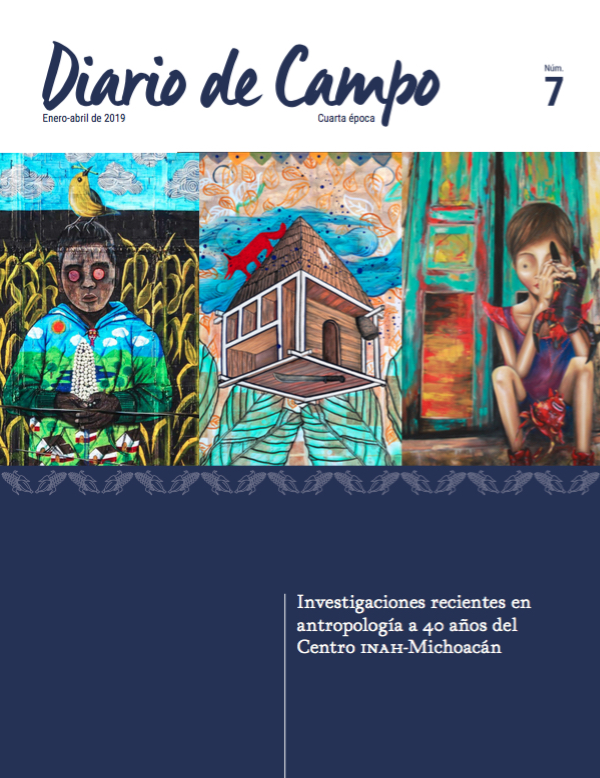Parhaquahpeni, the Back of the World. Approach to the Ritual and Social Vision of the Tarascans in the 16th Century
Keywords:
Worldview, Tarascan, human body, social organization, prehispanic architecture, Michoacan archeologyAbstract
We will analyze from archeological and historical point of view one of the few images that emerged about the creation of the Tarascan pre-Hispanic world. We observe its expression both in architecture and in social relations. We relate the different elements of the built of ritual space (yacatas and platforms) with the representation of the world as a “human back”. We proclaim that this part of the body served to represent the extension from which everything that inhabits the earth is created, as well as the surface that carries and sustains social relations. We observe how, based on different metaphors, the highest value of Tarascan society expressed: service and reciprocity between men and their relationship with the gods.
Downloads
References
Alcalá, Jerónimo de (2008). Relación de Michoacán (estudio introductorio Jean-Marie G. Le Clézio). Zamora: El Colegio de Michoacán.
Afanador-Pujol, Angélica Jimena (2015). The Relación de Michoacán (1539-1541) and the Politics of Representation in Colonial Mexico. Austin: University of Texas Press.
Diccionario grande de la lengua de Michoacán: tarasco-español (1991). Benedict Warren (ed.). Morelia: Fimax Editores.
Espejel Carbajal, Claudia (2008). La Justicia y el fuego. Dos claves para leer la Relación de Michoacán (t. I). Zamora: El Colegio de Michoacán.
Fisher, Chistopher, S. Leisz y G. Outlaw (2011). “Lidar: A Valuable Tool Uncovers an Ancient City in Mexico”, Photogrammetric Engineering and Remote Sensing. PE&RS, 77(10), pp. 962-966.
Gallardo Ruiz, Juan (2017). Hechicería, cosmovisión y costumbre. Una relación funcional entre el mundo subjetivo y la práctica de los curadores p’urhépecha. México: El Colegio de Michoacán / Instituto de Investigaciones Históricas- Universidad Michoacana de San Nicolás de Hidalgo / Editorial Morevalladolid.
Gilberti, Maturino (1997). Vocabulario en lengua de Mechuacan. Zamora: El Colegio de Michoacán / Fideicomiso Teixidor.
Lathrop, Maxwell (2007). Vocabulario del idioma purépecha (2ª ed. electrónica, 1ª ed.). México: Instituto Lingüístico de Verano. Recuperado de: http://www.sil.org/mexico/tarasca/G026-vocabulrioPurepecha-tsz.htm
Lumholtz, Carl (1945). El México desconocido, México: Publicaciones Herrerías.
Martínez, Roberto (2013). Cuiripu: cuerpo y persona entre los antiguos p’urhépecha de Michoacán. México: Universidad Nacional Autónoma de México.
Monzón, Cristina (2004). Los morfemas espaciales del p'urhépecha. Zamora: El Colegio de Michoacán.
_________ (2005). “Los principales dioses tarascos: un ensayo de análisis etimológico en la cosmología tarasca”. Relaciones. Estudios de Historia y Sociedad, XXVI(104), otoño, pp. 136-168.
_________y Adrew Roth-Seneff (2016). “Parentela como principio de Estado. El concepto cultural quahta en las fuentes tarascas del siglo XVI”. En Sarah Albiez-Wieck y Hans Roskamp (eds.), Nuevas contribuciones al estudio del antiguo Michoacán (pp. 95-119). Zamora: El Colegio de Michoacán.
Plancarte, Francisco (2009). “Archaeologic explorations in Michoacan, Mexico”. American Anthropologist, 6.
Pulido Méndez, Salvador (2006). Los tarascos y los tarascos uacúsecha. Diferencias sociales y arqueológicas en un grupo. México: INAH.
Ramírez, Francisco. “Relación sobre la residencia de Michoacán (Pátzcuaro) hecha por el padre Francisco Ramírez, Michoacán 4 de abril 1585” (1959). En Félix Zubillaga, S. J., Monumenta mexicana II (1581-1585) (pp. 492-496). Roma.
Swadesh, Mauricio (1969). Elementos del tarasco antiguo. México: IIH-UNAM.








